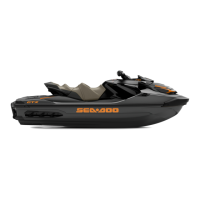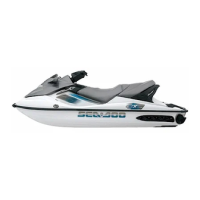Section 06 ENGINE MANAGEMENT (RFI)
Subsection 03 (COMPONENT ADJUSTMENT, INSPECTION AND REPLACEMENT)
TEMPERATURE RESISTANCE (OHMS)
°C °F NOMINAL LOW HIGH
-30 -22 12600 11800 13400
-20
-4
11400 11000 11800
-10
14
9500 8000 11000
0 32 5900 4900 6900
10 50 3800 3100 4500
20 68 2500 2200 2800
30 86 1700 1500 1900
40 104 1200 1080 1320
50 122 840 750 930
60 140 630 510 750
70 158 440 370 510
80 176 325 280 370
90 194 245 210 280
100 212 195 160 210
110 230
145
125 160
120 248
115
100 125
CONVERSION CHART FOR TEMPERATURE SENSORS
The resistance value of a temperature sensor may
test good at a certain temperature but it might be
defective at other temperatures. If in doubt, try a
new sensor.
Also remember this validates the operation of the
sensor at ambient temperature. It does not val-
idate the over temperature functionality. To test
it, the sensor could be removed from the engine/
muffler and heated with a heat gun while it is still
connected to the harness to see if the ECM will
detect the high temperature condition and gener-
ate a fault code.
When working with injectors, the resistance value
might test good while the complete current would
notflowthroughthewirewhenpulsatingcurrent
is supplied to the injector in its normal operation.
A solution would be to use a jumper wire to di-
rectly supply the injector from the VCM. If it now
works, replace the defective wire. A Noid light
(available from after-market tool/equipment sup-
pliers) may also be used to validate the injector
operation.
ECM Connectors
smr2005-056-004_a
ECM CONNECTORS IDENTIFICATION
The most recommended and safest method to
probe ECM connector terminals is to use the ECM
adapter (P/N 420 277 010).
420277010
This tool will prevent deforming or enlarging termi-
nals which would lead to bad ECM terminal con-
tact creating intermittent or permanent problems.
Disconnect the desired 1connector from ECM and
reconnect on the tool connector. Probe required
terminals directly in the tool holes.
smr2005-056 127

